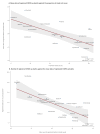Early unrecognised SARS-CoV-2 introductions shaped the first pandemic wave, Sweden, 2020
- PMID: 39392000
- PMCID: PMC11484920
- DOI: 10.2807/1560-7917.ES.2024.29.41.2400021
Early unrecognised SARS-CoV-2 introductions shaped the first pandemic wave, Sweden, 2020
Abstract
BackgroundDespite the unprecedented measures implemented globally in early 2020 to prevent the spread of SARS-CoV-2, Sweden, as many other countries, experienced a severe first wave during the COVID-19 pandemic.AimWe investigated the introduction and spread of SARS-CoV-2 into Sweden.MethodsWe analysed stored respiratory specimens (n = 1,979), sampled 7 February-2 April 2020, by PCR for SARS-CoV-2 and sequenced PCR-positive specimens. Sequences generated from newly detected cases and stored positive specimens February-June 2020 (n = 954) were combined with sequences (Sweden: n = 730; other countries: n = 129,913) retrieved from other sources for Nextstrain clade assignment and phylogenetic analyses.ResultsTwelve previously unrecognised SARS-CoV-2 cases were identified: the earliest was sampled on 3 March, 1 week before recognised community transmission. We showed an early influx of clades 20A and 20B from Italy (201/328, 61% of cases exposed abroad) and clades 19A and 20C from Austria (61/328, 19%). Clade 20C dominated the first wave (20C: 908/1,684, 54%; 20B: 438/1,684, 26%; 20A: 263/1,684, 16%), and 800 of 1,684 (48%) Swedish sequences formed a country-specific 20C cluster defined by a spike mutation (G24368T). At the regional level, the proportion of clade 20C sequences correlated with an earlier weighted mean date of COVID-19 deaths.ConclusionCommunity transmission in Sweden started when mitigation efforts still focused on preventing influx. This created a transmission advantage for clade 20C, likely introduced from ongoing cryptic spread in Austria. Therefore, pandemic preparedness should have a comprehensive approach, including capacity for large-scale diagnostics to allow early detection of travel-related cases and community transmission.
Keywords: COVID-19 pandemic; SARS-CoV-2; epidemiology; phylogenetics; viral respiratory tract infection.
Conflict of interest statement
Figures






Similar articles
-
A Founder Effect Led Early SARS-CoV-2 Transmission in Spain.J Virol. 2021 Jan 13;95(3):e01583-20. doi: 10.1128/JVI.01583-20. Print 2021 Jan 13. J Virol. 2021. PMID: 33127745 Free PMC article.
-
A small number of early introductions seeded widespread transmission of SARS-CoV-2 in Québec, Canada.Genome Med. 2021 Oct 28;13(1):169. doi: 10.1186/s13073-021-00986-9. Genome Med. 2021. PMID: 34706766 Free PMC article.
-
SARS-CoV-2 Genomic Variation in Space and Time in Hospitalized Patients in Philadelphia.mBio. 2021 Jan 19;12(1):e03456-20. doi: 10.1128/mBio.03456-20. mBio. 2021. PMID: 33468702 Free PMC article.
-
Molecular evolution of SARS-CoV-2 from December 2019 to August 2022.J Med Virol. 2023 Jan;95(1):e28366. doi: 10.1002/jmv.28366. J Med Virol. 2023. PMID: 36458547 Free PMC article. Review.
-
Travel-related control measures to contain the COVID-19 pandemic: a rapid review.Cochrane Database Syst Rev. 2020 Oct 5;10:CD013717. doi: 10.1002/14651858.CD013717. Cochrane Database Syst Rev. 2020. Update in: Cochrane Database Syst Rev. 2021 Mar 25;3:CD013717. doi: 10.1002/14651858.CD013717.pub2. PMID: 33502002 Updated.
Cited by
-
The effect of policy measures, school holidays and travel on the incidence of SARS-CoV-2 infection in children and adults in Estonia from 2021 to 2022.PLoS One. 2025 Jul 3;20(7):e0327719. doi: 10.1371/journal.pone.0327719. eCollection 2025. PLoS One. 2025. PMID: 40608757 Free PMC article.
References
MeSH terms
Supplementary concepts
LinkOut - more resources
Full Text Sources
Medical
Miscellaneous
